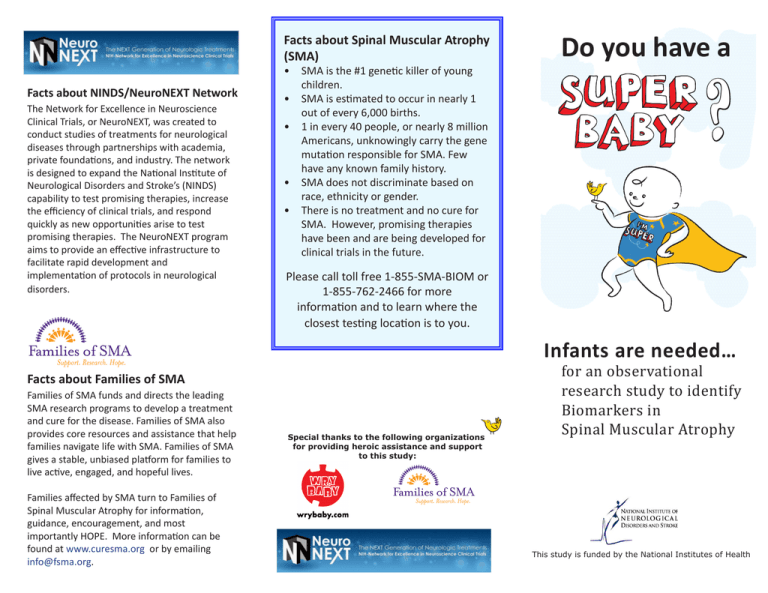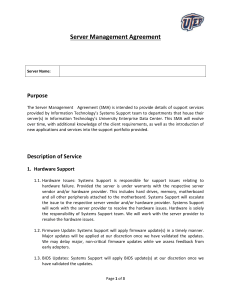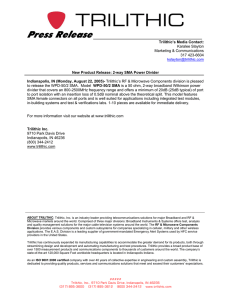? Do you have a
advertisement

Facts about Spinal Muscular Atrophy (SMA) Facts about NINDS/NeuroNEXT Network The Network for Excellence in Neuroscience Clinical Trials, or NeuroNEXT, was created to conduct studies of treatments for neurological diseases through partnerships with academia, private foundations, and industry. The network is designed to expand the National Institute of Neurological Disorders and Stroke’s (NINDS) capability to test promising therapies, increase the efficiency of clinical trials, and respond quickly as new opportunities arise to test promising therapies. The NeuroNEXT program aims to provide an effective infrastructure to facilitate rapid development and implementation of protocols in neurological disorders. • SMA is the #1 genetic killer of young children. • SMA is estimated to occur in nearly 1 out of every 6,000 births. • 1 in every 40 people, or nearly 8 million Americans, unknowingly carry the gene mutation responsible for SMA. Few have any known family history. • SMA does not discriminate based on race, ethnicity or gender. • There is no treatment and no cure for SMA. However, promising therapies have been and are being developed for clinical trials in the future. Do you have a ? Please call toll free 1-855-SMA-BIOM or 1-855-762-2466 for more information and to learn where the closest testing location is to you. Infants are needed… Facts about Families of SMA Families of SMA funds and directs the leading SMA research programs to develop a treatment and cure for the disease. Families of SMA also provides core resources and assistance that help families navigate life with SMA. Families of SMA gives a stable, unbiased platform for families to live active, engaged, and hopeful lives. Families affected by SMA turn to Families of Spinal Muscular Atrophy for information, guidance, encouragement, and most importantly HOPE. More information can be found at www.curesma.org or by emailing info@fsma.org. Special thanks to the following organizations for providing heroic assistance and support to this study: for an observational research study to identify Biomarkers in Spinal Muscular Atrophy This study is funded by the National Institutes of Health What is a Biomarker? A Biomarker is any laboratory measurement that reflects the activity or stage of a disease process. For example, cholesterol levels reflect heart disease risk. Biomarkers are being used effectively for cancer, diabetes, and heart disease to help determine whether new drugs are helping patients, and to better understand the diseases. The goal of the SMA Biomarker Project is to identify laboratory measurements that can be used in future SMA clinical trials. What is Spinal Muscular Atrophy? Spinal Muscular Atrophy (SMA) affects approximately 1 in 6,000 births, and it is the leading genetic killer of infants. SMA is a progressive neurological disease that affects both infants and children. Infants with SMA suffer from severe muscle weakness and atrophy of voluntary skeletal muscles. Muscle weakness in SMA is due to the death of the nerve cells (called the motor neurons) that connect the brain to muscle. Simply put, infants with SMA become weaker and weaker, which eventually affects every muscle in the body hindering the ability to walk, sit, stand, eat, swallow, and even breathe. What causes SMA? SMA is caused by mutations in the survival motor neuron gene (SMN1). Researchers now understand that these mutations result in a reduction in the amount of a protein, called SMN, which is crucial to the function of the motor neurons. Without this protein, motor neurons in the spinal cord degenerate and die. Who do we need for this study? We hope to learn how babies with SMA develop compared to their age matched peers. We therefore need two different types of “Super Babies” younger than 6 months of age for this study: 1) Infants who have been diagnosed with Spinal Muscular Atrophy 2) Infants with no medical condition Why are we doing this study in infants? Researchers have discovered that there is a “critical time period” when treatment is effective in SMA mice. In mice, this time period is immediately after birth. The same therapy given to the mice at a later time period is much less effective. At this time, no one knows if such a critical time period exists in humans. Biomarker studies have been done in patients 2 years of age and older. In this study, we will focus on infants with SMA to determine whether this “critical time point” exists in babies. That’s why we need both SMA and healthy infants to be “Super Babies for SMA” and Show Us The Way concerning: • When treatments in SMA should be given • What happens to SMN protein levels as children grow • What tests will be required for SMA clinical trials of the future How long would your child be in the study? Your child will be enrolled in the study until he/she turns 2 years of age. It is key that we get to see how your “Super Baby” grows and develops. What will be involved for your child? You and your child will come to a study site for regular study visits based on your child’s age. At these visits a variety of procedures will be performed, including: • Motor function tests • Non-invasive tests to measure the function of nerves and muscles • A blood draw that is performed on most, but not all, of the study visits. It is done after numbing cream is applied. How often would you come to the site for visits? The main point of this study is to see how the test results change in the same infant over the course of two years. Your child would come to the site on his or her chronological age at <1 month, 3 months, 6 months, 9 months, 12 months, 18 months, and 24 months. There will be a total of 7 visits if enrolled when the child is less than 3 months of age. You can be reimbursed for your travel, and will be paid $50 for each visit. When can you start? We can start talking about the study when you are pregnant. Once your child is born, he or she can enroll up to 6 months of age. What is the next step? Contact 1-855-762-2466 to learn where the closest testing location is to you.







